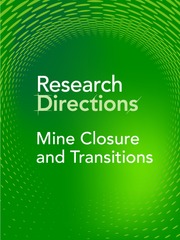Context
Over the life of a mining project, infrastructure is built, and mining activities alter the landscape. These activities create risks that may remain even with the implementation of rehabilitation and control measures during and after mining (Measham et al., Reference Measham, Walker, Haslam McKenzie, Kirby, Williams, D’Urso, Littleboy, Samper, Rey, Maybee, Brereton and Boggs2024). The goal for many mining operations is to relinquish the site to a clearly defined next landowner or manager who will take over responsibility for the site, including any known or unknown residual risks and liabilities (IGF, 2023).
Residual risk or liability is an important aspect of relinquishment, representing the risk or liability that remains after all closure activities have been completed (Tiemann et al. Reference Tiemann, McDonald, Middle, Dixon, Fourie and Tibbett2019). This liability will have different levels of consequence dependent upon what commodity was being mined, the environment in which the mining took place, the prevailing economic situation, the jurisdiction and the proximity of the operation to local communities and groups. It includes monitoring and maintenance to ensure that completed closure work has achieved (and continues to achieve) closure objectives, and future risks that were unknown at the time of closure and that are identified through post-closure monitoring or through an unexpected event. As such, it could include known liabilities such as water or geotechnical stability monitoring or management of invasive weeds; unforeseen risks and liabilities, such as unusual weather events; or where completed closure work did not perform as expected, such as the failure of a waste rock pile (IGF, 2023).
Even the most successfully closed mine sites have residual risk and liability. This risk needs to be assessed, accepted, and managed by governments, industry, and stakeholders for relinquishment to be a reality (Tiemann et al. Reference Tiemann, MacDonald, Young and Dixon2022). A miner must not only be able to identify the liability with an acceptable level of certainty, but they must also assess the ongoing risks that this liability poses in some form of quantifiable way so that a management plan can be developed, and an offset (e.g., funding mechanism or payment) can be determined that covers the management and cost of this residual risk into the future (Queensland Government, 2020).
The quantification of this risk and the related management plan and funding mechanism will be dependent upon the anticipated future use and critically must be deemed acceptable by the key actors involved in the transition. Where the post-mine use is mining related, the land will be kept within the same tenement model and the actors involved are simpler. Where an alternative use of the land or assets is proposed the model is more complex as it would require sign-off from potentially multiple government agencies so that the land can be relinquished and transferred to a different land use category. This is further complicated by what has been noted as an unwillingness from industry and government representatives or a lack of process for governments and stakeholders to accept residual risk, particularly in well-developed mining jurisdictions (IGF).
Repurposing of mined land and infrastructure has increasingly been seen as an important closure opportunity. Repurposing opportunities are diverse, offer the possibility of generating post-mining value and can attract investment using new and innovative technologies and solutions (Perlatti and Gagen, Reference Perlatti and Gagen2024). However, this can make the calculation and transfer of the residual risk, as well as the required management plan and funding mechanism much more complex. Repurposing also raises temporal complexity as the timing of residual risk assessment and agreement is critical to building investor confidence and enabling transitions to economic post-mine use. Spatial complexity is also common in repurposing opportunities, as post-mine developers may seek to only activate and transition part of the site for future economic use.
Innovative models for identifying and transferring residual risk to enable relinquishment and post-mine opportunity are required (Fig. 1). We invite papers to explore this theme and contribute papers that address potential research questions raised including:
-
What post-mining land use models are likely to minimize residual risks?
-
Who is responsible for the residual risk and how does this change with post-mine use?
-
Can residual risk be shared by multiple agents?
-
What policy and regulatory setting best protect governments interests in residual risks and liability?
-
Are current legal frameworks permissive to discharge the mine operator from residual risk responsibility? If not, what is required?
-
How should closure completion criteria be designed to minimize residual risk?
-
How can risk analysis models be structured or improved to support the acceptance of residual risk by governments and stakeholders?
-
Can residual risk be effectively partitioned and transferred across a site?
-
What type of innovative funding mechanisms could be put in place to manage residual risks?
-
What residual risk models are most conducive to attracting investment into post-mine economic use?
-
Are there alternative models where risks occur in perpetuity?
-
What are optimum models for third party management of residual risk?
-
How can mining companies, governments and communities engage over the Life of Mine to build confidence in residual risk transfer?
-
What case studies exist that demonstrate models of success in agreeing and transferring residual risk and liability?

Figure 1. Acceptable residual risk components.
How to contribute to this Question
If you believe you can contribute to answering this Question with your research outputs find out how to submit in the Instructions for authors (https://www.cambridge.org/core/journals/research-directions-mine-closure-and-transitions/information/author-instructions/preparing-your-materials). This journal publishes Results, Analyses, Impact papers and additional content such as preprints and “grey literature.” Questions will be closed when the editors agree that enough has been published to answer the Question so before submitting, check if this is still an active Question. If it is closed, another relevant Question may be currently open, so do review all the open Questions in your field. For any further queries check the information pages or contact this email mines@cambridge.org.
Competing interests
I can declare there are no competing interests as it relates to this paper, beyond my role as an Editor in Chief with the journal itself.





